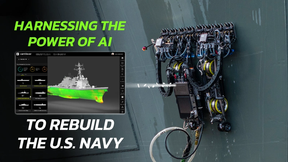China: Engine of the Asian Cruise Industry
Cruise holidays. Despite the now mundane miracle of aviation travel, Earth's deep oceans and seas still beckon to millions of holidaymakers year on year. Or, if perhaps not the water herself, then the concomitant aspects of contemporary cruise travel. A number of days if not weeks aboard a gargantuan, luxury-focused ship, which is replete from fore to aft with swimming pools, cafes, bars, restaurants, libraries, retail departments, casinos…did we mention bars, too? Magnificent. And if the isolation of being aboard a colossal wave-cutter, dining with captain and crew and reading your favorite book with your favorite cocktail while the sun glistens golden across the azure surface… yes, if all of that grows tiresome during your stay, you always have the option of disembarking when the cruise ship makes port. There's no harm in exploring a new city, is there?
Caribbean Cruises, Baltic Cruises, Mediterranean Cruises–for much of the previous decade these types of vacations have become synonymous with middle-aged and elderly westerners. Indeed, the average age of a cruise traveler in the west during the last decade has been around 49 years old.
Enter the Asian cruise industry. Now ranked second in the cruise market industry, having overtaken the Mediterranean. With 60 ships operating in the APAC region, 14 of those year round, and a grand total of 7,918 days travelled during 2016 by these ships—this industry is surging forwards. And that means that more jobs are going to be created. In shipbuilding, in testing, operation, maintenance and all the various roles that need to be fulfilled by cruise ship staff.
"China will overtake the U.S. and Europe at some point to be the largest cruising market in the world, so we are really excited to be here," these words from Arnold Donald—President and CEO of Carnival Corporation (the world's largest travel leisure company)—in answer to questions from CNBC back in February 2015, break down any doors of doubt or fugacity regarding the rapid rise of Asia's cruise industry. And, realistically, it isn't much of a surprise that China stands foremost behind this growth.
Between 2012 and 2014, the number of Chinese cruise-goers increased by around 79 percent. For more context, the actual number in 2014 was roughly 703,000 people. 2015 figures increased even further, up to 986,000. Zheng Weihang, Executive Vice President of the China Cruise and Yacht Industry Association, predicts that by the year 2030, seven million Chinese holidaymakers will enjoy their vacations on cruise ships every year.
As of February 2017, Carnival Corporation had signed a binding memorandum of agreement with Italian shipyard Fincantieri and the China State Shipbuilding Corporation. The agreement? The building of two cruise ships, in China, for the Chinese market. The agreement includes options to requisition the building of up to four more ships.
The two ships, which have a combined value of approximately $1.5 billion, will be delivered in 2023 and operated by a new Chinese cruise brand.
Princess Cruises and Norwegian Cruise Line both announced in 2015 that they will be custom-building new ships for the Chinese market, to launch in 2017. Norwegian CEO, Frank Del Rio, stated their new ship "will have characteristics that are authentic to Norwegian Cruise Line, and yet distinctively Chinese in all of its sensibility. It will perfectly suit what modern Chinese travelers value from an upscale cruise experience."
Perhaps one of the biggest considerations in strategizing for financial growth in the Asia cruise industry is creating an experience that does not feel culturally alien. Chinese food, speakers of Mandarin and other popular APAC languages, as well as tables for culturally-relevant board games such as mah-jong, have been invested in to maximize the Asia cruise experience. A cynic might also argue that developing newer ships to suit a fresh audience is easier than renovating older ships. Cruise major player Royal Caribbean re-based its young vessels, Quantum of the Seas and Ovation of the Seas, to China.
Despite the heavy involvement of western major market players—Carnival Corporation is a U.S.-U.K. company—the cruise-goers of APAC are creating their own statistical landscape with regards to cruise trends. For example, four out of 10 Asians embarking on cruises in the APAC region are under 40 years old. And the cruise holiday length is shorter, with a whopping 48 percent of APAC travellers preferring a four-six day trip.
Both of these statistics do come with caveats. Will the 25-40 year-olds going on cruises now, still go when they begin their senior years? Quite possibly; however, will they bring with them their children, their grandchildren? Depending on the answer, the average could fluctuate. More ships will inevitably mean more customers, which in turn will grow the regional interest of APAC natives, but will the trends change? Only time will tell.
What is also curious, is that, as recently as 2016, statistics counted that 84 percent of Asian cruise-goers were using cruises to visit other destinations within the APAC region, rather than pursuing other cruise markets. As of 2016, Japan was the most frequented country, with 1,526 port calls in 2016. China (850) was second; the single most-visited port was South Korea’s Jeju Island. Given the geographical setup of Asia-Pacific, it does not seem surprising that the region's natives are using cruises as a way of touring the countries nearby.
"China's policy to encourage the cruise economy is part of its strategy to promote marine industry as well as tourism," Angela Yu, an analyst at IHS, said. China's industrial vision has, it seems, no blind spots.
The Author
Lucy Smith is Marine Account Manager of Worldwide Recruitment Solutions Ltd (WRS)
















